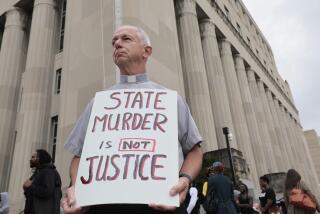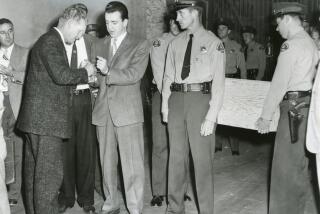Caryl Chessman’s infamous death row case is revisited
‘When You Read This, They Will Have Killed Me’
The Life and Redemption of Caryl Chessman, Whose Execution Shook America
Alan Bisbort
Carroll & Graf: 414 pp., $27.95
*
‘Cell 2455, Death Row’
A Condemned Man’s Own Story
Caryl Chessman
Introduction by Joseph E. Longstreth and Alan Bisbort
Carroll & Graf: 362 pp., $15.95, paper
*
ON Jan. 23, 1948, near the intersection of Sixth Street and Vermont Avenue, a 26-year-old career criminal named Caryl Chessman was arrested after a high-speed car chase and subsequently charged as Los Angeles’ “Red Light Bandit,” a thief who preyed on couples in parked cars. Although the robberies were minor, the Bandit forced two women to have oral sex with him, telling one that he was motivated by an unfaithful wife. Because these women had been forcibly taken from their cars, Chessman was tried for kidnapping under California’s Little Lindbergh law. He was sentenced to the gas chamber -- kidnapping was a capital offense -- and sent to death row at San Quentin, where he spent the next 12 years.
Chessman’s story should have ended there -- or more accurately, with his execution, originally scheduled for June 1952. That it didn’t is a testament to his tenacity, his power to persevere. By the time he was finally put to death on May 2, 1960, he was the world’s most famous convict, a symbol for death penalty opponents everywhere. He had appeared on the cover of Time and was the author of four books, including “Cell 2455, Death Row,” a bestseller in 1954.
“His case drew support from all corners of the globe and all areas of human endeavor,” writes Alan Bisbort in “ ‘When You Read This, They Will Have Killed Me’: The Life and Redemption of Caryl Chessman, Whose Execution Shook America,” “from the sacred (Pope John, Albert Schweitzer, Episcopal Bishop James A. Pike) to the profane (Steve Allen, Shirley MacLaine, Marlon Brando), from the cerebral (Aldous Huxley, Christopher Isherwood, William F. Buckley) to the mundane.” Yet half a century later, in a culture still beset by the issue of capital punishment, he is essentially forgotten, a footnote to history.
“ ‘When You Read This, They Will Have Killed Me’ ” is an attempt to put the Chessman case in context. For Bisbort, a Connecticut journalist, it’s a story defined by contradictions, not least the one between the sentence and the crime. Chessman always maintained his innocence in this case, and given the forthrightness with which he detailed his life as a criminal, it’s impossible not to give some credence to that claim.
Even if he was the Red Light Bandit, to be sentenced to death for a series of robberies in which no one was killed was unfair and extreme. During his early years on death row, this inequity consumed him; he was a hard case, a discipline problem, a man with no way out. Only after his first stay of execution did Chessman have what Bisbort calls a “Road-to-Damascus, life-changing moment,” when Warden Harley Teets challenged him to make something of himself.
Here, we have a second contradiction -- that even for a man on death row, prison might offer some hope of rehabilitation. With Teets’ encouragement, Chessman produced the manuscript that would become “Cell 2455, Death Row” and got an agent, Joseph Longstreth, who would champion the condemned man’s work.
Yet after the book appeared, and Chessman became a cause celebre, officials, including Teets, rescinded his right not only to publish but to write. In one inflammatory comment, Clarence Linn, an assistant to then-California Atty. Gen. Pat Brown, argued, “The prison people can take the manuscript out in the back yard and burn it if they choose to do so.”
All of this is quite compelling, highlighting Chessman’s struggles not just to live but to express himself.
What’s missing, though, is any sense of interiority, of what drove Chessman, before and after he came to death row. That’s the most fundamental contradiction: how this man, so smart in so many ways, could also be so dumb. Urged to cop a plea, he defended himself in the Red Light Bandit trial, almost as if, Bisbort notes, he was “working in league with the prosecution.” For Bisbort, this is a sign of arrogance, but rather than look deeper he chooses to frame Chessman as a mythic figure, a 20th century Francois Villon.
It’s a tempting conceit but, in the end, overstated, as is much of Bisbort’s writing in this book. At one point, he likens the San Quentin gas chamber to the Nazi death camps. Elsewhere, he writes that “[w]hile the word ‘gulag’ may be too fraught with contemporary political overtones to be entirely fair, Chessman’s efforts to write his book against the wishes of the state recalls the struggles faced by Alexandr Solzhenitsyn during his years in a Siberian gulag as a guest of the Soviet Union.”
I agree that Chessman was probably railroaded in this case, and didn’t deserve such punishment either way. Still, to compare a criminal -- even one on death row -- to a man imprisoned for his political beliefs under the harshest prison camp conditions is not just ridiculous but irresponsible, and it undermines the credibility of the book.
“ ‘When You Read This, They Will Have Killed Me’ ” is being published in conjunction with a reissue of the long out-of-print “Cell 2455, Death Row,” and it’s instructive to read the two works side-by-side. Featuring an introductory essay written by Longstreth in 1970 (and updated by Bisbort), Chessman’s book is searing, relentless: a countermyth, if you will. That’s not what you’d expect from a jailhouse memoir, especially one written while its author was fighting for his life. Chessman, however, seems almost pathologically willing to reveal himself, even when it casts him in a negative light.
During one early run-in, he absconds with a rival’s girlfriend; “I’m taking the blonde here,” he growls in an eerie prelude to the Red Light crimes. Yet paradoxically, this only enhances his authority, our sense that he is telling us the truth. Even when the book veers into hyperbole -- as when he asserts that a 1943 prison escape was motivated by the desire to go to Germany and assassinate Adolf Hitler -- it’s a hyperbole that feels authentic to who he is.
More to the point, “Cell 2455, Death Row” offers an unsentimental portrait of its author’s troubled history, from his criminal activities to his battles in the courts. Most affecting is his account of death row’s psychological toll. “You don’t let anyone know how you feel,” he writes. “You grin, hideously perhaps, but still you grin.... Sure, you’re ready to die; you’ve been ready for a long time. Only you’re still obstinate. You still aren’t ready to let them kill you. You aren’t ready to let them win. Sometimes some small inner voice tries to tell you that you still have a future, and that is when you want to laugh uproariously. Because this is your future. The gas chamber is your future (at least symbolically). Death is your future. And the Death Row is all there is for you.”
Ultimately, the Chessman saga raises fundamental questions about our humanity, about crime and punishment, about how we treat the lowest of the low. Yes, Chessman was a bad guy, but on death row, it appears, he managed to renew his soul. In the process, he may have helped jump-start the 1960s, with many budding radicals protesting on his behalf.
For the cynics, Chessman was a sham, a put-on artist. Yet if “Cell 2455, Death Row” -- and to a lesser extent “ ‘When You Read This, They Will Have Killed Me’ ” -- is any indication, there’s something more at work. As Chessman put it in a 1955 magazine piece: “Long after I should have been dead, I wrote myself back to sanity.”
David L. Ulin is book editor of The Times.
More to Read
Sign up for our Book Club newsletter
Get the latest news, events and more from the Los Angeles Times Book Club, and help us get L.A. reading and talking.
You may occasionally receive promotional content from the Los Angeles Times.







